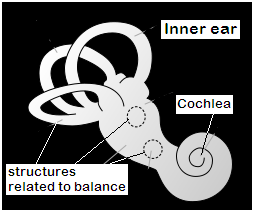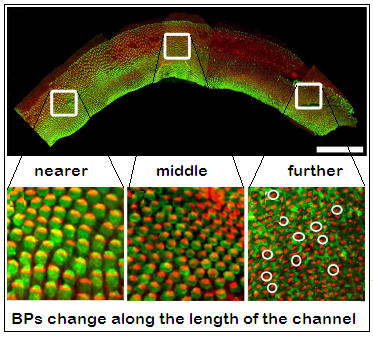The ears of animals develop in the way fine musical instrument are built, says S.Ananthanarayanan.
Musical instruments are built to produce series of tones of exact pitch. The piano, for instance, has 88 keys, which can produce notes of frequency as low as 27 cycles a second (cps) to as high as 4,186 cps. The strings, which are struck when the keys are pressed, however, need to be tuned just right, so that relationship between notes is always the same – and even the untrained ear can tell the difference of just one cps, in the middle range.
The ears of vertebrates have complex internal structure, to tell apart such fine differences of pitch, over a very wide range, from 20 cps to nearly 1,00,000 cps. Zoe F. Mann, Benjamin R. Thiede, Weise Chang, Jung-Bum Shin, Helen L. May-Simera, Michael Lovett, Jeffrey T. Corwin and Matthew W. Kelley, of Maryland, Virginia and London report in the journal, Nature Communications, that they have pinned down the genetic bases of this enormous sensitivity of the hearing organs of animals. The researchers identify the role of a genetic agent, Bmp7, which leads to production of a protein, Bone Morphogentic Protein 7 (BMP7) and then regulates the growth of minute organs that react to closely separated pitch of sounds entering the ear.
The structure of the ear is basically an arrangement to collect and amplify waves, to separate them according to pitch and then to detect sounds of different pitch and cause electrical signals to flow to the brain. The first two functions are of the outer ear and middle ear, while the last functions are of the inner ear. The middle ear has an elastic membrane, the ear drum, which is set vibrating, to transmit its movement to the inner ear with the help of three bones, the hammer, the anvil and the stirrup, with an amplification of the sound by nearly thirty times. The inner ear has a fluid in a long and spiral shaped container, the cochlea, where sound of different pitch concentrate at different parts, where there are fine, hair-like cells that respond and set off chemical changes that affect nerves that carry signals to the brain. As sound is transmitted to a liquid, the same frequency has a much shorter wavelength and the inner ear remains compact.

The arrangement has incredible sensitivity. Even the human ear, which is not the most sensitive, among animals, can react to sounds where the pressure difference is less than one billionth of the atmospheric pressure. Such a faint sound corresponds to movement of air by the distance of a tenth of an atomic diameter! And then, the arrangement is incredibly sturdy, the sounds can get so loud as corresponding, for an instant, to 10,000 times the atmospheric pressure. This sensitivity, in the human ear, is over the range of frequency, or pitch, from 20 cps to 20,000 cps. Dogs can hear up to 40,000 to 60,000cps, while cats go as high as79,000 cps and dolphins and bats, which use high pitched sound for navigation, can hear sounds at 100,000 cps. Mice also make and hear sounds as shrill as 79,000 cps, for communication, outside the range of normal predators, and the sensitivity of cats is probably an adaptation to get the mice anyway.
But range of frequency apart, the remarkable feature of the ears is the ability to tell the difference of very small change in frequency. The spiral of the cochlea is only about 3.2 cms long, but it is able to separate about 1,500 different frequencies, using 16,000 to 20,000 hair cells. This amounts to a separate frequency being focused every 0.002cm. Even with just a dozen or so hair cells assigned to each frequency, such high resolution would need some form of sharpening of the response to pitch along the length of the cochlea, a mechanism that is still not understood.
But the question that the group at Maryland, Virginia and London addressed was of how the hair cells positioned themselves along the length of the Cochlea, so that they could separately respond to such closely separated frequencies of sound. In the standard piano, there are 230 strings, which need to be tuned, in groups, to 88 specific frequencies. This would take a skilled piano tuner a few hours to complete, usually with the help of an electronic device to provide the reference note while adjusting the tension of the strings. The construction of the cochlea may correspond to setting the position of 1,500 frets along the neck of single stringed guitar!
The researchers used as the model for study the hair cells, which are actually cells of the nature of skin, known as basilar palilae (BP). that are found in the sound sensitive part of the ear of the developing chicken. These cells, which are found in birds, lizards and amphibians, correspond to the organs in the cochlea of mammals, and eggs, unlike foetus, permit intervention and study of the course of development. Fertilised eggs of White Leghorn chickens were incubated, for study at different stages of growth of the embryo, between day 6 to day 14. The embryos were extracted from the eggs and the BPs were extracted, BPs at the start of the hearing channel being kept separate from those at the far end. The genetic signaling material, which directs the formation of specific proteins, was then extracted and classified, to create a map of the variation of the nature of the BPs along the length of the hearing channel.

The study revealed that there was a gradient or a rising slope in the population of Bmp7, the progenitor of the protein that modifies BPs, as one passed along the axis of the hearing sensitive channel. To make sure that this was the factor that controlled frequency response, trials were made with engineered disruption of the distribution of Bmp7 along the channel, whether after extraction of the BPs or while they were still in the egg. This action was found to correspondingly affect the nature of the hair cells formed, and their sensitivity to frequencies. The role of Bmp7 was tested in different settings and it was clear that it is the level of the BMP7 protein that leads to tone sensitivity of the ear. Further examination of how Bmp7 levels vary and how they communicate to affect cell growth showed a pathway that involves an enzyme called TAK1, whose activation decides how hair cells would respond to frequencies along the sound sensitive channel.
Specific placing of different forms of cells along an axis arises in other organs as well, like along the axes of the body, in parts of the embryo that develop into the central nervous system in the hind and fore limbs. Here again, it is arising slope in the presence of agents that affect cells that regulate cell growth along axes. The role of Bmps is found in many of these mechanisms and the manner of their action seems to be related to the way hair cells in the ear are positioned.